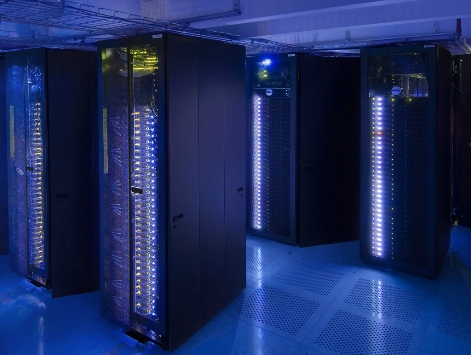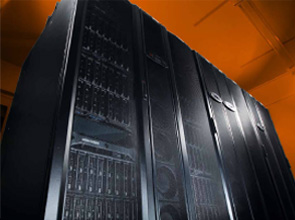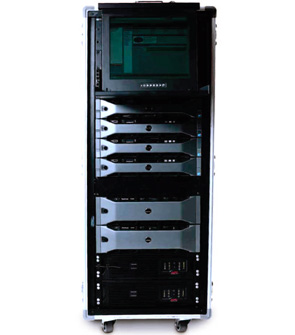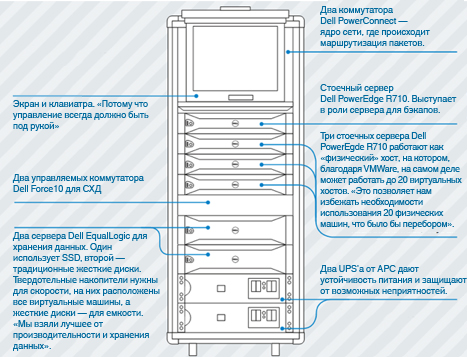Behind the Scenes of Formula 1
The role of computers in the "royal race" is hardly difficult to underestimate. It's no joke: without a laptop today, you can't even start a car. Yes, this is a completely different sport, not at all what it was represented in the 50s. IT technologies have penetrated every corner of this incredible sport, creating cars that look like fighters and making drivers real pilots. Just imagine: impressive supercomputers the size of several refrigerators, allowing engineers to search through dozens of designs for any node in a matter of hours and choose the best one that will go to the “printout”. Mobile servers deployed in “marching” data centers, bullet-proof laptops, gigabytes of data running half a mile after a few milliseconds after they were collected from hundreds of car sensors. All this is the real world of Formula 1. Do you know what else is very important in this sport? Team. And today we want to talk about how the Dell and Intel teams helped the Caterham team to adequately enter the amazing world of F1 racing.
And the creation of a racing car - with the design. Usually, it takes nine months of hard work for the team to go from the first sketches to the start of the engine, but the fall of 2009 simply did not give Catherham a chance to go the beaten track. The team received a "green light" to participate in the first race of the new season in Bahrain, which means that it had only 22 weeks left for everything about everything. Looking ahead, let's say that the story had a happy ending and the team even received the title of “Best newcomer of the 2010 season”. But it all began in one of the rooms of Cambridge - the "blue room".

')
In general, the title would be quite drawn to the next book about the adventures of Harry Potter :), but you can't throw the words out of the song, and the room is really called that. It’s all about backlighting from Dell’s university supercomputer. This HPC cluster is a true veteran of high-performance computing, noted at the frontiers of biology, chemistry, astronomy and, of course, physics (used in some CERN calculations for subatomic particles). It was just such a car that the new racing team needed, since the work was just gigantic. In fact, even with the computing power of a supercomputer behind, Caterham did not greatly facilitate his task. It would not have been possible to rent a university cluster completely for any money, so a volitional decision was made: to use the facilities of the Cambridge “room” until our own supercomputer was designed and built. But in parallel, it was necessary to find qualified CFD-engineers who were to have time not only to design the car, but also to make the project a reality. All this provided the “enthusiasts” with a rather merry winter of 2009: the team practically settled near the supercomputer (in fact, rented one of the nearby premises of the university). Caterham’s “obsession” was so infectious that some university staff, based on their long-standing practice of “communicating” with Dell’s high-performance systems, together with the company's technical support, helped develop their own cluster for the team’s needs. As a result, the "beast" turned out, of course, more modest than the university one, but it was the best for the price / needs of the team. If we compare the two supercomputers, then the Cambridge HPC sample of 2010 with 3,584 cores "on board" won against Caterham (1,488 cores) in power by five times. Let's get acquainted with the latest closer.

A real magician never reveals all his secrets. Therefore, the subtle technical points can be found in the comments. In general, the Caterham supercomputer is 186 Dell servers, each of which housed 8 Intel CPUs based on Intel Xeon. The “computational power” is headed by three large servers responsible for visualizing all the calculations that the cluster produces.
The final results are usually provided for analysis by engineers in the form of images, videos or graphs. Otherwise, one would have to “play the Matrix,” staring at endless streams of billions of numbers and equations. In general, such clusters most often in Formula 1 perform the same mission: they are used to solve problems in computational fluid dynamics. In other words, they are responsible for modeling the influence of certain elements of the car on its aerodynamics. Even some 10 years ago, engineers could only dream of such an approach. A new part had to be made manually, then tested in a wind tunnel ... And all this only in order to try one of the options. Now the modeling of the results takes hours. During the 17-hour “working” day, the cluster performs about 10 billion calculations using about 800 million “units” of initial data.
Actually, there is no talk of any respite and there can be no talk: the solution is operated 24x7 almost all year round. The exception is two weeks in August, when all teams are forbidden to work on the cars. It is these days that major upgrades, updates, and iron diagnostics are made. The rest of the days there is no time for this (although with urgent need any of the 186 servers can be pulled into a “private conversation”).
In addition, it is no secret that the technician does not like to complete the work suddenly. What to say about supercomputers. To maintain a Caterham cluster in the event of a power outage, 60 24-volt batteries are used, which can hold it for up to 12 minutes at maximum load.
But no matter how well this supercomputer worked, he had no more than a year to live in the F1 team. The fact is that the project was launched in April 2010, and according to tradition in the “royal races” the life cycle of the IT-park is no more than 3 years. And now the team is eyeing the new Dell solutions. The aspirations are simple: faster, more compact, energy efficient. Speaking in terms of calculations, if at the moment the cluster needs about “CFD-work” for about 17 hours, the new solution should cope with a similar volume in 10.
Just do not think that all the "IT-shnost" racing Formula 1 team ends on a supercomputer. No, no, this is just the tip of the iceberg, or more precisely, the development center, located in England. But after all races take place almost the whole year. And this means that “in the rear” the equipment is even more interesting.

Meet this mobile rack - the mobile technological heart of the Caterham team. A sort of "man-orchestra", carrying on its board 20 virtual servers that provide comfortable work for 60 people. She is responsible for almost everything that happens on the track. For example, it is through it that the processing of all telemetry during the race is organized, which allows engineers to adjust the strategy on the fly and adjust the car. Another important component of the “half-rack” (here it is necessary to understand that the name came from a comparison with the dimensions of the “classic” rack) is its capacity and “throughput”. After all, for each of the two races (qualification + the race itself) it is necessary to accept and redirect about 20 gigabytes of data to the “think tank” in England. More information about the "composition" of the rack can be found in the figure:

We turn to the nuances. First of all, for Formula 1, everything related to “iron” is directly subject to the saying “size matters”. In fact, of course, not only size, but also weight. It is difficult for an ordinary person to even imagine how expensive it is to transport anything in the “royal races”. The cost of transporting 1 kg of weight is usually about $ 100. Now multiply this by 20 moves, and it will become obvious why teams prefer to make their lives as easy as possible in every sense of the word. Funny, but a UPS that provides stable rack performance is superior in weight. However, “lightness on the rise” is only one of the requirements applied to equipment “in the field”. Particular attention is paid to impact resistance, protection from vibrations, as well as the ability to work in adverse weather conditions. Yes, what problems can there be when you have on hand a clean server room with a powerful cooling system. But only all this in the desert, unfortunately, no. Dust, dirt, sand and insects are what most often have to face a service engineer here. Nevertheless, the weekend over the weekend, the equipment works by taking data simultaneously from two cars, sending them to the data center for processing and at the same time giving out the results needed for the work of 60 engineers, managers and “strategists” of the race. Not bad for a half meter black box, isn't it?
Well, before we talk about the smallest IT-units involved in the race, let's summarize the small results collected in infographics.

Finally we got to the workstations. Dell Precision M4600 - this is the model of not quite ordinary laptops since 2010 used in the Caterham F1 Team. We will talk more about the technical characteristics in the next post. Now we will dwell on the question “Why?”. Why exactly these laptops are used in Formula 1?
The answer is simple - ordinary laptops go to the “valley of blue screens of death” at the stage of starting the car engine. The noise level reaches 140 decibels, which, coupled with the attendant vibrations, clearly declares the need to use SSD-drives.

Also, do not forget that the races are held almost all year round around the world. This means that the laptop should work correctly in all weather conditions, whether it is the wet autumn of Spain, the heat in Abu Dhabi, the sandy winds of Bahrain or 80% humidity in Malaysia.
Theater starts with a hanger
And the creation of a racing car - with the design. Usually, it takes nine months of hard work for the team to go from the first sketches to the start of the engine, but the fall of 2009 simply did not give Catherham a chance to go the beaten track. The team received a "green light" to participate in the first race of the new season in Bahrain, which means that it had only 22 weeks left for everything about everything. Looking ahead, let's say that the story had a happy ending and the team even received the title of “Best newcomer of the 2010 season”. But it all began in one of the rooms of Cambridge - the "blue room".

')
In general, the title would be quite drawn to the next book about the adventures of Harry Potter :), but you can't throw the words out of the song, and the room is really called that. It’s all about backlighting from Dell’s university supercomputer. This HPC cluster is a true veteran of high-performance computing, noted at the frontiers of biology, chemistry, astronomy and, of course, physics (used in some CERN calculations for subatomic particles). It was just such a car that the new racing team needed, since the work was just gigantic. In fact, even with the computing power of a supercomputer behind, Caterham did not greatly facilitate his task. It would not have been possible to rent a university cluster completely for any money, so a volitional decision was made: to use the facilities of the Cambridge “room” until our own supercomputer was designed and built. But in parallel, it was necessary to find qualified CFD-engineers who were to have time not only to design the car, but also to make the project a reality. All this provided the “enthusiasts” with a rather merry winter of 2009: the team practically settled near the supercomputer (in fact, rented one of the nearby premises of the university). Caterham’s “obsession” was so infectious that some university staff, based on their long-standing practice of “communicating” with Dell’s high-performance systems, together with the company's technical support, helped develop their own cluster for the team’s needs. As a result, the "beast" turned out, of course, more modest than the university one, but it was the best for the price / needs of the team. If we compare the two supercomputers, then the Cambridge HPC sample of 2010 with 3,584 cores "on board" won against Caterham (1,488 cores) in power by five times. Let's get acquainted with the latest closer.

A real magician never reveals all his secrets. Therefore, the subtle technical points can be found in the comments. In general, the Caterham supercomputer is 186 Dell servers, each of which housed 8 Intel CPUs based on Intel Xeon. The “computational power” is headed by three large servers responsible for visualizing all the calculations that the cluster produces.
The final results are usually provided for analysis by engineers in the form of images, videos or graphs. Otherwise, one would have to “play the Matrix,” staring at endless streams of billions of numbers and equations. In general, such clusters most often in Formula 1 perform the same mission: they are used to solve problems in computational fluid dynamics. In other words, they are responsible for modeling the influence of certain elements of the car on its aerodynamics. Even some 10 years ago, engineers could only dream of such an approach. A new part had to be made manually, then tested in a wind tunnel ... And all this only in order to try one of the options. Now the modeling of the results takes hours. During the 17-hour “working” day, the cluster performs about 10 billion calculations using about 800 million “units” of initial data.
Actually, there is no talk of any respite and there can be no talk: the solution is operated 24x7 almost all year round. The exception is two weeks in August, when all teams are forbidden to work on the cars. It is these days that major upgrades, updates, and iron diagnostics are made. The rest of the days there is no time for this (although with urgent need any of the 186 servers can be pulled into a “private conversation”).
In addition, it is no secret that the technician does not like to complete the work suddenly. What to say about supercomputers. To maintain a Caterham cluster in the event of a power outage, 60 24-volt batteries are used, which can hold it for up to 12 minutes at maximum load.
But no matter how well this supercomputer worked, he had no more than a year to live in the F1 team. The fact is that the project was launched in April 2010, and according to tradition in the “royal races” the life cycle of the IT-park is no more than 3 years. And now the team is eyeing the new Dell solutions. The aspirations are simple: faster, more compact, energy efficient. Speaking in terms of calculations, if at the moment the cluster needs about “CFD-work” for about 17 hours, the new solution should cope with a similar volume in 10.
"Field work
Just do not think that all the "IT-shnost" racing Formula 1 team ends on a supercomputer. No, no, this is just the tip of the iceberg, or more precisely, the development center, located in England. But after all races take place almost the whole year. And this means that “in the rear” the equipment is even more interesting.

Meet this mobile rack - the mobile technological heart of the Caterham team. A sort of "man-orchestra", carrying on its board 20 virtual servers that provide comfortable work for 60 people. She is responsible for almost everything that happens on the track. For example, it is through it that the processing of all telemetry during the race is organized, which allows engineers to adjust the strategy on the fly and adjust the car. Another important component of the “half-rack” (here it is necessary to understand that the name came from a comparison with the dimensions of the “classic” rack) is its capacity and “throughput”. After all, for each of the two races (qualification + the race itself) it is necessary to accept and redirect about 20 gigabytes of data to the “think tank” in England. More information about the "composition" of the rack can be found in the figure:

We turn to the nuances. First of all, for Formula 1, everything related to “iron” is directly subject to the saying “size matters”. In fact, of course, not only size, but also weight. It is difficult for an ordinary person to even imagine how expensive it is to transport anything in the “royal races”. The cost of transporting 1 kg of weight is usually about $ 100. Now multiply this by 20 moves, and it will become obvious why teams prefer to make their lives as easy as possible in every sense of the word. Funny, but a UPS that provides stable rack performance is superior in weight. However, “lightness on the rise” is only one of the requirements applied to equipment “in the field”. Particular attention is paid to impact resistance, protection from vibrations, as well as the ability to work in adverse weather conditions. Yes, what problems can there be when you have on hand a clean server room with a powerful cooling system. But only all this in the desert, unfortunately, no. Dust, dirt, sand and insects are what most often have to face a service engineer here. Nevertheless, the weekend over the weekend, the equipment works by taking data simultaneously from two cars, sending them to the data center for processing and at the same time giving out the results needed for the work of 60 engineers, managers and “strategists” of the race. Not bad for a half meter black box, isn't it?
Well, before we talk about the smallest IT-units involved in the race, let's summarize the small results collected in infographics.

And now to the zoo finish line
Finally we got to the workstations. Dell Precision M4600 - this is the model of not quite ordinary laptops since 2010 used in the Caterham F1 Team. We will talk more about the technical characteristics in the next post. Now we will dwell on the question “Why?”. Why exactly these laptops are used in Formula 1?
The answer is simple - ordinary laptops go to the “valley of blue screens of death” at the stage of starting the car engine. The noise level reaches 140 decibels, which, coupled with the attendant vibrations, clearly declares the need to use SSD-drives.

Also, do not forget that the races are held almost all year round around the world. This means that the laptop should work correctly in all weather conditions, whether it is the wet autumn of Spain, the heat in Abu Dhabi, the sandy winds of Bahrain or 80% humidity in Malaysia.
Source: https://habr.com/ru/post/155367/
All Articles